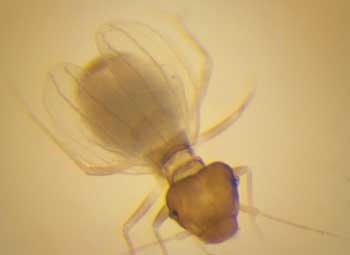The discovery of a new genus of a tiny booklouse from a northern Arizona cave may lead to further protection for cave ecosystems.
J. Judson “Jut” Wynne, a Northern Arizona University doctoral student and cave research scientist with the U.S. Geological Survey’s Southwest Biological Science Center, and Kyle Voyles, a cave researcher from Parashant National Monument, recently discovered a new genus of psocopteran (booklouse) from a cave on the western edge of the Grand Canyon-Parashant National Monument.
This is the third new genus of invertebrates found by the two scientists since 2006. Wynne and Voyles discovered a new cricket genus and a new millipede genus in Grand Canyon region caves. They also have unearthed 15 new insect species from Grand Canyon region caves.
“I am hopeful these findings will help cave ecosystems get a seat at the conservation table,” Wynne said. “We want to see cave ecosystems factored into regional conservation management planning.”
Edward Mockford, a taxonomist from Illinois State University, will soon release a name for the new genus. He said the booklouse is from the family Sphaeropsocopsis, but is distinguished from other genera by its unusual wing structure.
“In the past, very little attention was given to cave ecosystems,” Voyles said. “It was thought that caves couldn’t contain a significant biodiversity, so they were mostly ignored. These newly discovered ecosystems are now the principal management concern for these caves and will no longer being ignored.”
Wynne said that this discovery of another new genus living in a fragile cave ecosystem will help scientists understand invertebrate evolution in association with cave environments, and is encouraging land and conservation managers to increase the protection of caves along the northern edge of the Grand Canyon.
“Now that we have another new genus discovery, land managers are beginning to recognize the importance of cave ecosystems,” Wynne explained. “We are working with them on developing biodiversity inventory and monitoring strategies, and ways to monitor visitor impacts.”



